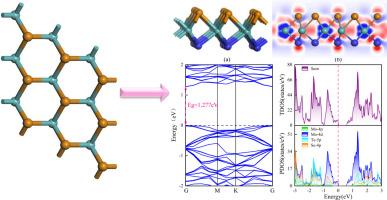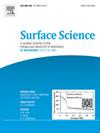Janus MoTeSe单层膜的双轴应变调制光电响应
IF 1.8
4区 化学
Q3 CHEMISTRY, PHYSICAL
引用次数: 0
摘要
基于第一性原理密度泛函理论计算,系统研究了双轴应变(- 9% ~ 9%)对Janus单层MoTeSe结构稳定性、电子性能和光学性能的调制机制。原始单层的直接带隙为1.277 eV。在双轴拉伸应变下,带隙明显收窄,从1.277 eV减小到0.021 eV,从而提高了载流子迁移率。值得注意的是,半导体到金属的转变发生在9%的拉伸应变。相反,双轴压缩应变引起从直接带隙到间接带隙的转变。光学分析表明,拉伸应变引起吸收峰的红移,并将能量损失重新定位到较低的能量上。相比之下,压缩应变引起吸收蓝移,吸收系数(从1.062 × 105cm-1增加到1.278 × 105cm-1)和光收集能力显著增加。此外,压缩应变提高了静态介电常数,在- 9%应变时达到3.061。研究揭示了双轴应变在调制Janus MoTeSe光电特性中的作用。为基于应变工程的可调谐光电器件的设计提供了理论依据。本文章由计算机程序翻译,如有差异,请以英文原文为准。

Biaxial strain modulating optoelectronic responses in Janus MoTeSe monolayers
The modulation mechanism of biaxial strain (-9 % to 9 %) on the structural stability, electronic properties, and optical properties of Janus monolayer MoTeSe is systematically investigated based on first-principles density functional theory calculations. The pristine monolayer exhibits a direct bandgap of 1.277 eV. Under biaxial tensile strain, the bandgap narrows significantly, decreasing from 1.277 eV to 0.021 eV, thereby enhancing carrier mobility. Notably, a semiconductor-to-metal transition occurs at 9 % tensile strain. Conversely, biaxial compressive strain induces a shift from a direct to an indirect bandgap. Optical analysis reveals that tensile strain causes a red shift in the absorption peaks and relocates energy loss to lower energies. In contrast, compressive strain induces a blue shift in absorption, substantially increasing the absorption coefficient (from 1.062 × 105cm-1 to 1.278 × 105cm-1) and light-harvesting capability. Additionally, compressive strain elevates the static dielectric constant, reaching 3.061 at -9 % strain. The study reveals the role of biaxial strain in modulating the optoelectronic properties of Janus MoTeSe. It provides a theoretical basis for the design of tunable optoelectronic devices based on strain engineering.
求助全文
通过发布文献求助,成功后即可免费获取论文全文。
去求助
来源期刊

Surface Science
化学-物理:凝聚态物理
CiteScore
3.30
自引率
5.30%
发文量
137
审稿时长
25 days
期刊介绍:
Surface Science is devoted to elucidating the fundamental aspects of chemistry and physics occurring at a wide range of surfaces and interfaces and to disseminating this knowledge fast. The journal welcomes a broad spectrum of topics, including but not limited to:
• model systems (e.g. in Ultra High Vacuum) under well-controlled reactive conditions
• nanoscale science and engineering, including manipulation of matter at the atomic/molecular scale and assembly phenomena
• reactivity of surfaces as related to various applied areas including heterogeneous catalysis, chemistry at electrified interfaces, and semiconductors functionalization
• phenomena at interfaces relevant to energy storage and conversion, and fuels production and utilization
• surface reactivity for environmental protection and pollution remediation
• interactions at surfaces of soft matter, including polymers and biomaterials.
Both experimental and theoretical work, including modeling, is within the scope of the journal. Work published in Surface Science reaches a wide readership, from chemistry and physics to biology and materials science and engineering, providing an excellent forum for cross-fertilization of ideas and broad dissemination of scientific discoveries.
 求助内容:
求助内容: 应助结果提醒方式:
应助结果提醒方式:


